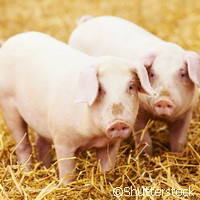European scientists contribute to greater understanding of the pig genome
Almost 200 scientists worldwide including key European teams conducted research on the pig genome: their results helped pinpoint genes that are useful in pork production, and increased our knowledge of the health, science and history of the pig. This research is published in the scientific journal Nature this month. It is funded by a variety of grants: the advanced European Research Council (ERC) project SELSWEEP ('Molecular characterization of genetic factors in the pig under selection during speciation, domestication and breeding'), and European collaborative projects SABRE ('Cutting edge genomics for sustainable animal breeding') (Sixth Framework Programme or FP6) and QUANTOMICS ('From sequence to consequence: tools for the exploitation of livestock genomes') (Seventh Framework Programme or FP7). Professor Alan Archibald of the Roslin Institute at the University of Edinburgh, United Kingdom, and one of the paper's lead authors, says: 'Agriculture in particular will benefit fast. The pig industry has an excellent track record for rapid adoption of new technologies and knowledge.' Some of their research methods included comparing the genome of a common farm pig,Sus scrofa domesticus, with those of 10 wild boars - all from different parts of Europe and Asia. Researchers also compared the pig genome with those of the human, mouse, dog, horse and cow, and found similarities between pigs and humans, along with a few distinct differences. Comparisons of Asian and European wild boars revealed significant genetic differences, the result of their separating from one another around 1 million years ago. One of the principal investigators of the study, Professor Larry Schook from the University of Illinois, elaborates on this dissimilarity: 'They have been separated so long that the Asian and European lineages are almost sub-species now and the European and Asian wild boars lost a lot of genetic diversity about 20,000 years ago, likely as a result of a global glaciation event.' Professor Martien Groenen from Wageningen University continues: 'We had evidence from previous studies, but those studies focused on the mitochondrial DNA, a small DNA molecule only inherited from the mother. With the complete genome sequence of multiple wild boars we now have a much clearer picture about these events.' Researchers also found that the pig has more unique olfactory genes (their sense of smell) than humans, mice or dogs. And while pigs can smell a world of things humans and many other animals can't (truffles being one of them), their sense of taste is diminished. This is due to the fact that pigs have fewer bitter taste receptor genes than humans, and the genes involved in perception of sweet and umami flavours (which humans perceive as meaty) are also different. The new analysis also supports the use of the pig in studies of human diseases. In total, there are 112 positions where the porcine protein has the same amino acid, which is implicated in a disease in humans. Professor Martien Groenen notes: 'By also sequencing the genomes of another 48 pigs, we identified many more gene variants implicated in human disease, further supporting the pig as a valuable biomedical model. Some of the protein aberrations pigs share with humans are associated with obesity, diabetes, dyslexia, Parkinson's disease and Alzheimer's disease. The aim of this research is to provide a range of new breeding strategies to improve animal health and welfare, reduce chemical and energy inputs, minimise livestock waste and pollution, and maximise food safety and quality.For more information, please visit: Nature http://www.nature.com/news/pig-geneticists-go-the-whole-hog-1.11801SABRE: http://www.sabre-eu.eu/Home/tabid/135/Default.aspxQUANTOMICS:http://www.quantomics.eu/



